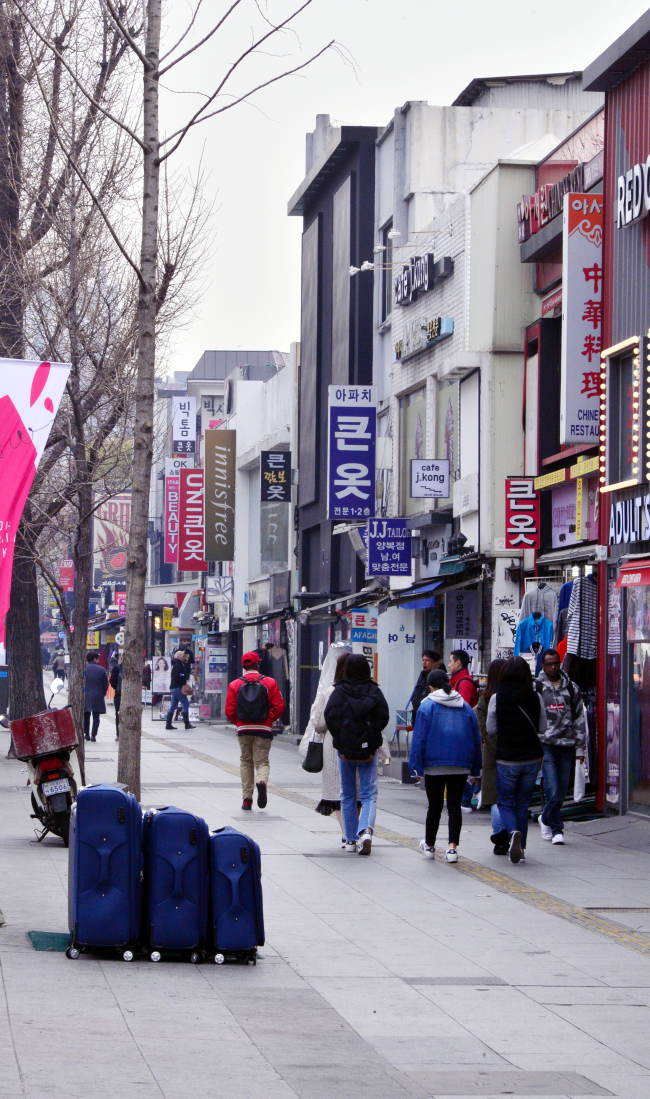Some say Itaewon has lost its soul and is now just another soulless hangout place for young Koreans.
Others say the neighborhood has become safer and trendier -- suitable for a wider audience. And if you stand in the right place, you can still find the same expat-led culture thriving, they say.
Whichever side one takes, the talk resembles the typical debate that erupts whenever a neighborhood gets gentrified. A less developed area with its unique characteristics and a vibrant local community gets discovered by outsiders. Money flows in, and new, trendier and fancier places pop up. Rents rise and many original residents and the old places they loved are priced out.
 |
Itaewon (Park Hyun-koo/The Korea Herald) |
“Mainly because Itaewon was a rather run-down area for many years,” Lance Reegan-Diehl, a Canadian who worked and lived around Itaewon for nearly two decades, said of the changes taking place in Itaewon.
“Lots of reasons for that, but no one knows (exactly) why. But the small-town feel of Itaewon is gone.”
He was among many expats feeling the losses of once famed bars, restaurants and other retail businesses -- many of which were run by expats. Now replaced by franchise coffee chains, beauty stores or big fashion brand outlets, the area seems to draw in more young Korean customers.
Nestled in the shadow of the city’s central mountain Namsan, Itaewon had long enjoyed unparalleled status as the nexus of expat life in Seoul, with its close proximity to the US military base and a large number of foreign embassies.
In a socially conservative and racially homogenous country, the neighborhood was unique in its striking cultural diversity and laissez-faire atmosphere, although some Koreans feared it to be infested with crime, says Moon Gwang-lip, a former journalist who has written a book of essays on Itaewon and its foreign inhabitants.
“Not sophisticated or high-brow, but Itaewon has always had raw elements of culture and community. The forces of gentrification appear to be eroding them,” he said.
 |
Itaewon (Park Hyun-koo/The Korea Herald) |
What Itaewon is changing into is a tidier place with glossy shops that offer a not-so-different consumption experience for Koreans, he added.
The Korea Herald took a stroll down Itaewon’s main street last weekend from where the landmark Hamilton Hotel stands, navigating through its many back alleys that lead to the Seoul Central Mosque, up the Antique Furniture Street and further north to nearby Gyeongnidan and Haebangchon.
The main Itaewon street had steady but small foot traffic from the directions where two nearby subway stations -- Itaewon and Noksapyeong -- are located.
Quite a few retail spaces were vacant. Clothing shops specializing in large sizes, tailors and leather shops were nearly devoid of shoppers, but two Olive Young stores were bustling with mostly young Korean and Asian shoppers, with a clerk on a microphone continuously inviting pedestrians inside. It was the last day of a big sale, she said.
An expat in casualwear haggled with a street vendor over a fake Nike cap and walked away.
“It’s difficult to make a living. Koreans don’t buy from my stall and not many foreigners come here to shop as they used to,” said the vendor, who refused to give her name.
Near the mosque, women wearing hijab were grocery shopping at a halal supermarket while African expats casually chatted in front of a convenience store. Intentional efforts are being taken by the Muslim community here to preserve what has become known as “Islamic Street,” according to an official at the Yongsan-gu Office, who pointed out that an African community also finds its home in the area.
An Indian resident in Haebangchon said despite many changes, Itaewon still holds a unique charm for foreign residents and visitors.
“Of course it changed a lot. But Itaewon retains the same old charm that I fell in love with when I first came to Korea back in 2002.”
Yet, Itaewon’s changes so far may look trivial, once developers start tearing down old homes and rebuilding neighboring residential areas.
“Itaewon sits near those hot residential areas expected to get a major upscale makeover in the coming years. For better or worse, changes are inevitable,” said one local realtor.
By Lee Sun-young (
milaya@heraldcorp.com)









![[Today’s K-pop] Blackpink’s Jennie, Lisa invited to Coachella as solo acts](http://res.heraldm.com/phpwas/restmb_idxmake.php?idx=644&simg=/content/image/2024/11/21/20241121050099_0.jpg)